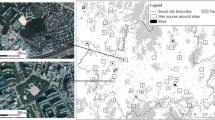Abstract
The vascular plant species richness of upland urban forest patches in St. Paul and Minneapolis, Minnesota, was found to be positively related to their size. There was no significant relationship between species richness and the distance of these patches to other patches. Mowing and trampling reduced species richness of patches, whereas planting increased richness. Landscape richness can be maintained at a relatively high level by leaving even small unmown forested patches within a more disturbed matrix. However, maximizing landscape diversity would require leaving large forest stands unmown. It is suggested that cultivation be deliberately used as a mechanism for increasing native species richness in urban forests.
Similar content being viewed by others
References
Airola, T.M. and Buchholz, K. 1984. Species structure and soil characteristics of five urban forest sites along the New Jersey Palisades. Urban Ecol. 8: 149–164.
Boecklen, W.J. and Gotelli, N.J. 1984. Island biogeographic theory and conservation practice: species-area or specious-area relationships? Biol. Cons. 29: 63–80.
Buckley, R.C. 1982. The habitat-unit model of island biogeography. J. Biogeogr. 9: 339–344.
Carlton, T.J. and Taylor, S.J. 1983. The structure and composition of a wooded urban ravine system. Can. J. Bot. 61: 1392–1401.
Connor, E.F. and McCoy, E.D. 1979. The statistics and biology of the species-area relationship. Am. Nat. 113: 791–833.
Crowe, T.M. 1979. Lots of weeds: insular phytogeography of vacant urban lots. J. Biogeogr. 6: 169–181.
Curtis, J.T. 1959. The Vegetation of Wisconsin: An Ordination of Plant Communities. The University of Wisconsin Press, Madison, Wisconsin. 657 pp.
Davis, A.M. and Glick, T.F. 1978. Urban ecosystems and island biogeography. Env. Cons. 5: 299–304.
Gilbert, F.S. 1980. The equilibrium theory of island biogeography: fact or fiction? J. Biogeogr. 7: 209–235.
Helliwell, D.R. 1976. The effects of size and isolation on the conservation of wooded sites in Britain. J. Biogeogr. 3: 407–416.
Hobbs, E.R. In press. Using ordination to analyze the composition and structure of urban forest islands. For. Ecol. Mgt.
Hoehne, L.M. 1981. The groundlayer vegetation of forest islands in an urban-suburban matrix. In Forest Island Dynamics in Man-Dominated Landscapes, pp. 41–54. Edited by R.L. Burgess and D.M. Sharpe. Springer-Verlag, New York. 310 pp.
Johnson, M.P., Mason, L.G. and Raven, P.H. 1968. Ecological parameters, and plant species diversity. Am. Nat. 102: 297–306.
Levenson, J.B. 1981. Woodlots as biogeographic islands in southeastern Wisconsin. In Forest Island Dynamics in Man-Dominated Landscapes, pp. 13–39. Edited by R.L. Burgess and D.M. Sharpe. Springer-Verlag, New York. 310 pp.
Marschner, F.J. 1974. The Original Vegetation of Minnesota (map). St. Paul: U.S. Dept. of Agriculture, Forest Service, North Central Forest Experiment Station. (Redraft of the original 1930 edition).
McArthur, R.H. and Wilson, E.O. 1967. The Theory of Island Biogeography. Princeton University Press, Princeton, N.J. 203 pp.
Middleton, J. and Merriam, G. 1983. Distribution of woodland species in farmland woods. J. Appl. Ecol. 20: 625–644.
Ray, A.A. (ed.) 1982. SAS User's Guide: Statistics. SAS Institute, Gary, North Carolina.
Riebesell, J.F. 1982. Arctic-alpine plants on mountaintops: agreement with island biogeography theory. Am. Nat. 119: 657–674.
Sauer, J.D. 1969. Oceanic islands and biogeographical theory: a review. Geograph. Rev. 59: 582–593.
Scanlon, M.J. 1981. Biogeography of forest plants in the prairie-forest ecotone of western Minnesota. In Forest Island Dynamics in Man-Dominated Landscapes, pp. 97–124. Edited by R.L. Burgess and D.M. Sharpe. Springer-Verlag, New York. 310 pp.
Tramer, E.J. and Suhrweir, D.E. 1975. Farm woodlots as biogeographic islands: regulation of tree species richness. Bull. Ecol. Soc. Am. 56: 53.
Whittaker, R.H. 1977. Evolution of species diversity in land communities. Evol. Biol. 10: 1–67.
Author information
Authors and Affiliations
Rights and permissions
About this article
Cite this article
Hobbs, E.R. Species richness of urban forest patches and implications for urban landscape diversity. Landscape Ecol 1, 141–152 (1988). https://doi.org/10.1007/BF00162740
Issue Date:
DOI: https://doi.org/10.1007/BF00162740




